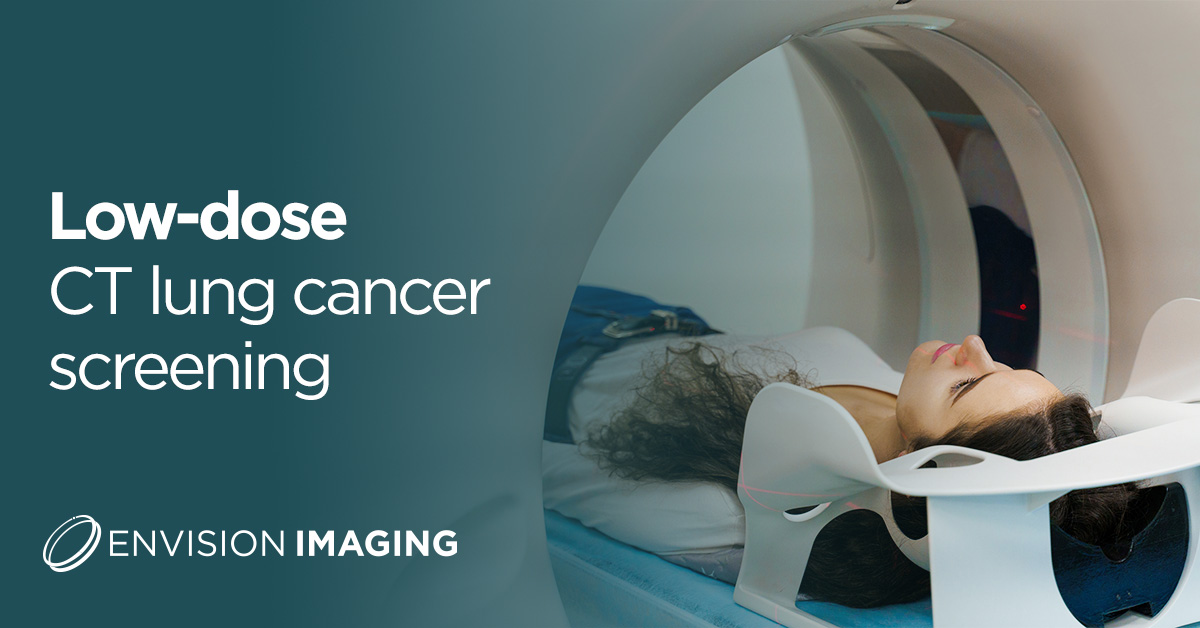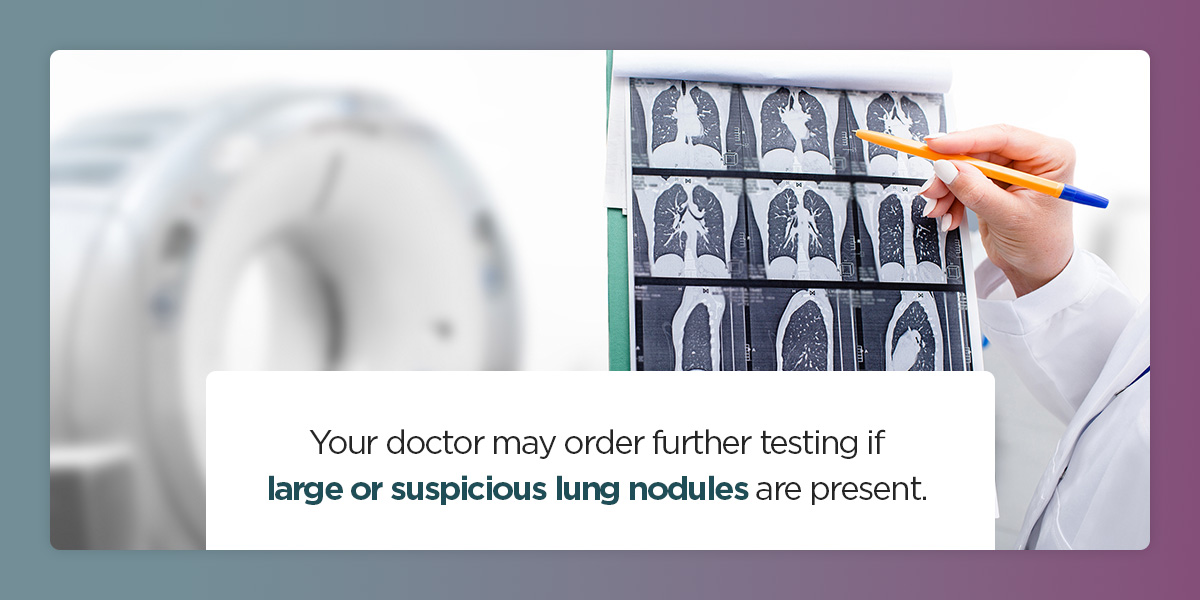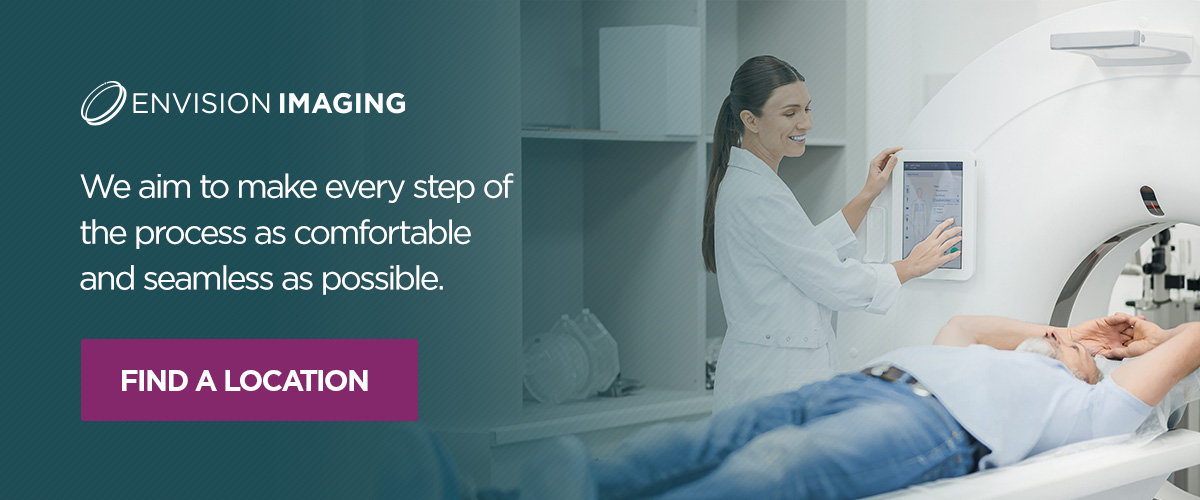Low-dose CT lung cancer screening

A low-dose computed tomography (LDCT) lung cancer screening is an x-ray exam that takes detailed photos of the lungs. It aims to detect lung cancer at its early stage, making it easier to cure. By the time lung cancer symptoms develop, the condition is often too advanced for curative treatments. As such, lung cancer screening may increase the chance of survival.
LDCT scans use smaller doses of radiation, as they examine nodules (abnormal growths) in low-density lung tissue. Essentially, an LDCT lung cancer screening functions like a traditional CT scan but with less radiation.
Jump sections
- When should you get LDCT lung cancer screening?
- What should you expect at your screening?
- What do your results mean?
- What are the potential risks of LDCT lung cancer screening?
- What are the benefits of LDCT lung cancer screening?
- LDCT lung cancer screening FAQs
- Choose Envision Imaging for LDCT lung cancer screening
When should you get LDCT lung cancer screening?
The following groups are recommended to undergo annual lung cancer screening:
- Current and former smokers aged 50 and older
- People who have smoked heavily for several years (20 pack years or longer)
- Formerly heavy smokers who quit in the last 15 years
Pack years are calculated with the following formula:
Packs of cigarettes smoked per day × the number of years you smoked
What should you expect at your screening?
Here are the three main stages of an LDCT lung cancer scan and what you can expect during each phase:
1. Preparation
Preparing for this screening is simple. The technologist will ask you to remove any metal objects, such as watches and jewelry. They’ll explain how the procedure works and answer any questions you might have.
You’ll either stay in your regular clothes or change into a hospital gown. Let your technologist know if you have a respiratory infection, as this could affect your scan results.
2. Examination
You’ll lie down on a long table, which slides in and out of the wide, donut-shaped opening of the scanner. Make sure you remain as still as possible so the images don’t appear blurry. You may be asked to hold your breath for brief periods. Hearing clicking or whirring sounds during the exam is also expected.
You can easily see out of both ends of the scanner and speak to your technologist through a two-way microphone. The technologist will monitor you constantly, talking you through the entire procedure. You can press the intercom button anytime if you encounter any issues or concerns.
3. Review
Once the scan is complete, the technologist will review the images to ensure everything looks clear. They’ll then discharge you, and you can go about your day normally. The technologist will share the results with your doctor. Your doctor will contact you to discuss these results and the next steps.
What do your results mean?

Here are the possible results of LDCT lung cancer screening and what they often indicate:
- Large nodules: Your doctor may order further testing if large or suspicious lung nodules are present. A large nodule is more likely to be cancerous. Your doctor might suggest a positron emission tomography (PET) scan or biopsy to determine if you have cancer. If the nodule is cancerous, your doctor will discuss potential treatment routes with you, such as surgery, radiation, chemotherapy or immunotherapy.
- Small nodules: If a small lung nodule is present, your doctor may ask you to return for a follow-up scan to see if it has grown.
- No nodules: The absence of lung nodules and other irregularities usually means there is no cause for concern. However, even if no nodules are present, your doctor will probably ask you to return each year for a scan.
Helping patients stop smoking is another foundational part of the process. If you currently smoke, your doctor may provide you with resources to help you quit.
What are the potential risks of LDCT lung cancer screening?
The possible risks of LDCT lung cancer screening include:
- False positive results. A CT scan can sometimes produce a false positive result, indicating the patient has lung cancer when they actually don’t. False positives can lead to further invasive testing and treatments that aren’t necessary.
- Radiation exposure. There is always a risk of developing cancer with any degree of radiation exposure. However, LDCT scans use much lower radiation doses than standard CT scans, so this risk is very minimal.
While there are potential risks associated with any CT scan, not receiving a scan when your doctor recommends one is even riskier. Early cancer detection increases the likelihood of overcoming the condition. Diagnostic imaging can help your doctor identify and treat issues as soon as possible.
What are the benefits of LDCT lung cancer screening?
Here are some advantages of LDCT lung cancer screening and CT scans in general:
- Quick and painless: Due to their noninvasive nature, LDCT scans are typically pain-free and quick to perform.
- Early disease detection: Lung cancer is among the most common types in the United States, accounting for 21% of cancer deaths in 2023. A CT scan can detect possible lung tumors before you experience any symptoms. As previously mentioned, these symptoms may not appear until the condition has reached advanced stages. The sooner your doctor can detect your condition, the sooner they can begin treatment, increasing the likelihood of long-term survival.
- Improved treatment: Because of their small radiation doses, LDCT lung cancer scans enable more frequent exams. In turn, they allow for a more comprehensive cancer screening program. These periodic examinations can inform your care team of new or changing nodules. That way, they can decide if further investigation is in order.
LDCT lung cancer screening FAQs
If you have other questions or concerns about your LDCT lung cancer scan, we’ve answered some common questions below. Feel free to browse our FAQ page if you have other questions about CT scans or diagnostic imaging in general.
1. Will insurance cover a CT scan?
Generally, insurance covers medically necessary CT scans and other imaging exams. Most health insurance companies cover lung cancer screening for individuals who meet the high-risk criteria. Before your appointment, call your insurance provider to confirm they will cover it. Determine if you’ll be responsible for any out-of-pocket fees, as well.
2. What are the possible side effects of an LDCT lung cancer scan?
LDCT lung cancer screenings don’t involve any medications, needles or contrast dyes. Therefore, there are typically no associated side effects.
3. How long does an LDCT lung cancer scan take?
Most of the time is spent preparing for the scan. The exam itself should only take a couple of minutes.
Choose Envision Imaging for LDCT lung cancer screening
LDCT lung cancer screening is an effective, noninvasive way to catch and treat cancer in its early stages. If you think you need an LDCT lung cancer scan, turn to Envision Imaging for world-class radiology services.
We offer an array of diagnostic imaging procedures, including CT scans. We aim to make every step of the process as comfortable and seamless as possible through:
- Flexible and responsive scheduling.
- Compassionate and affordable care.
- Timely and consistent imaging results.
Find an Envision Imaging location near you to request your CT lung scan today.



